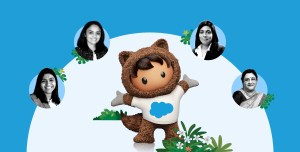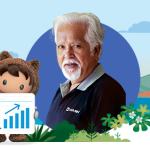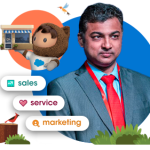A 2021 World Economic Forum report revealed that yet another generation of women would have to wait for gender parity – 135.6 years, to be precise. But these grim figures don’t discourage women leaders; it only pushes them to accelerate their efforts to ‘break the bias’ every day.
This International Women’s Day, the Salesforce Women’s Network in India hosted a panel with some inspiring business leaders. The session focussed on how both women and men can break existing gender biases and work towards a more inclusive environment.
It turns out that the secret recipe to break biases only involves four simple ingredients: two tablespoons of empathy, one tablespoon of awareness, a sprinkle of support, and a large helping of conscious behaviour in our everyday lives.
 Leading the conversation were:
Leading the conversation were:  Arundhati Bhattacharya
Arundhati Bhattacharya
Chairperson and CEO, Salesforce India  Rucha Nanavati
Rucha Nanavati
CIO, Mahindra Group  Annapurna Vishwanathan
Annapurna Vishwanathan
CIO, Cummins India  Jijy Oommen
Jijy Oommen
CIO, Aavas Financiers Ltd
Tip 1: Break the internal biases first
Often, one of the biggest hurdles that women face is the ‘imposter syndrome.’ It is loosely defined as the internal experience of believing that you are not as competent as others perceive you to be. While it is, unfortunately, the result of years of discrimination, recognising and overcoming this feeling of self-doubt can help build the required confidence to rise above biases.
“It all starts with asking yourself the question – ‘Can I do it? Am I capable?’. Once you learn to answer that confidently, you begin to speak up,” Nanavati explained as she described what imposter syndrome actually is.
Most internal biases are unconsciously held. Therefore, the most crucial element to break bias is to recognise the bias. While some are easy to spot, most of them are often deep-rooted in our psyche. It takes years of education, awareness, self-evaluation, and reflection to uncover unconscious biases we each may hold.
Eventually, once we start believing in ourselves, we begin to confidently ask for what we deserve. And, once we break our inner biases, we can speak out against external biases as well.
Tip 2: Tweak your inner monologue
Most often than not, what we tell ourselves tends to be worse than reality. Especially while dealing with feelings of guilt and inadequacy because of gender. It is very important to acknowledge these feelings and understand where they stem from.
Vishwanathan recalled how tweaking her inner monologue helped her overcome biases. “As a working mother of a young child, I felt as though I was falling behind in the corporate race. I would see friends/peers slowly starting to earn more than me. However, a couple of years later, when I was ready to run the race again, I was pleasantly surprised to be offered the same compensation as they were receiving at that time.
“This helped boost my self-confidence and, most importantly, helped me realise that my internal agony was purely a result of my incorrect assumptions.”
Tweaking our inner monologue also involves accepting ourselves for who we are and validating our feelings. For decades women have been trying to be more ‘man-like.’
“That approach is flawed simply because women and men are not the same. To work towards equality, women don’t have to become men; they need to play to their strengths. Regardless of their gender, each person brings something unique to the table, and we must recognise differences – and even encourage them – instead of trying to blur the lines,” Vishwanathan explained.
“Women are known to be empathetic; these are strengths that must be cultivated and celebrated,” said Nanavati, while discussing the need to recognise and internalise differences between men and women.
Tip 3: Dispel age-old stereotypes
To strive for an equal world, both men and women must dispel age-old stereotypes associated with both genders.
Bhattacharya recounted an experience early on in her career that opened her eyes to the stereotypes she herself held.
“I was once told by a male colleague that my body language was aggressive. I dismissed him immediately and said this is precisely the problem women go through – a little bit of confidence is considered aggression. Much later, when I had the chance to watch a recording of myself interacting at a conference, I was taken aback to learn that my body language was indeed aggressive.
“The stereotype that I held about how men perceive strong women made me dismiss genuine advice and feedback. I realised gender bias works both ways and that we need to examine ourselves periodically to overcome them.”
From time to time, examine the stereotypes you may be holding. Your pre-existing notions may hinder your learning process and make you closed to new experiences.
Tip 4: Cultivate allies and mentors
To drive change, we need to build allies that share the same vision. A culture of equality can be created by roping in the right people and resources to ensure discussions are turned into actions.
Organisations can lead the way by creating policies that enforce equality and leave no room for discrimination. For instance, at Salesforce, all hiring managers are required to go through training to recognise and break unconscious bias. This mandatory certification, besides other practices, helps establish inclusive hiring practices.
It also helps to work on awareness programmes and consciously assign mentors to drive empathy and support. Having a sound support system will help guide you and mentor you to go beyond self-imposed or societal-set limitations.
Nanavati shared an incident where timely advice from her mentor helped her become more aware of her behaviour. “I recall the time I was seated in the corner of a boardroom where I was supposed to make a presentation. Our COO at the time, also a woman, shot me a text that read, “This is your day, take the centre seat. Sit where you belong”. That advice stayed with me, it made me question why I chose to sit in the corner, and from then on, I paid extra attention to my choices and actions.”
Mentors and leaders can help us understand and spot biases. This collective effort can drive the much-needed culture of change.
Oommen added that while designated mentors are a great idea, one must also proactively strive to reach out and help others. “Turn interaction opportunities with your team to mentoring sessions and build an open culture that values feelings and extends support.”
While we work toward making our workplace more inclusive, we must also strive to build a support system at home. Engaging in candid discussions with our families will help us understand different perspectives and be more respectful of everyone’s feelings. Learning indeed starts at home as Bhattacharya pointed out: “Start with building an A-team at home that supports you and the rest will follow.”




























